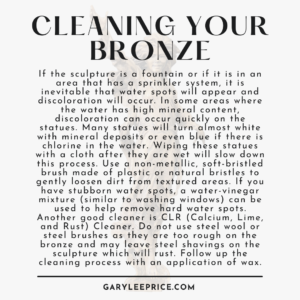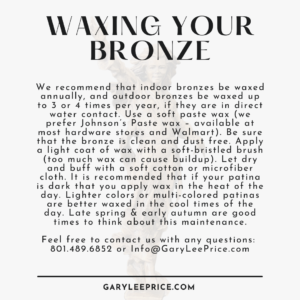One of the wonderful aspects of bronze is that it changes with time. The ancient statues of the bronze age are weathered and many of them blue-green in color. The bronze alloy we use is approximately 95% copper and is directly affected by its environment including water, air, and all of the chemicals included therein.
Cleaning your bronze:
If the sculpture is a fountain or if it is in an area that has a sprinkler system, it is inevitable that water spots will appear and discoloration will occur. In some areas where the water has high mineral content, discoloration can occur quickly on the statues. Many statues will turn almost white with mineral deposits or even blue if there is chlorine in the water. Wiping these statues with a cloth after they are wet will slow down this process. Use a non-metallic, soft-bristled brush made of plastic or natural bristles to gently loosen dirt from textured areas. If you have stubborn water spots, a water-vinegar mixture (similar to washing windows) can be used to help remove hard water spots.
Another good cleaner is CLR (Calcium, Lime, and Rust) Cleaner. Do not use steel wool or steel brushes as they are too rough on the bronze and may leave steel shavings on the sculpture which will rust. Follow up the cleaning process with an application of wax.
Waxing your bronze:
We recommend that indoor bronzes be waxed annually, and outdoor bronzes be waxed up to 3 or 4 times per year if they are in direct water contact. Use a soft paste wax (we prefer Johnson’s Paste wax – available at most hardware stores and Walmart). Be sure that the bronze is clean and dust free. Apply a light coat of wax with a soft-bristled brush (too much wax can cause buildup). Let dry and buff with a soft cotton or microfiber cloth. It is recommended that if your patina is dark that you apply wax in the heat of the day. Lighter colors or multi-colored patinas are better waxed in the cool times of the day. Late spring & early autumn are good times to think about this maintenance.
If you are not satisfied with your bronze aging, the last resort would be to have the piece re-patinaed. This process would likely involve removing the bronze from its permanent location and having a fine art foundry complete the process which can get quite costly, but it can be done!
Please contact us if you have any questions, and above all – enjoy your new piece of art!
Gary Lee Price Studios, Inc.
Phone: 801.489.6852
info@garyleeprice.com
**Save the images below to your device, for future reference.



